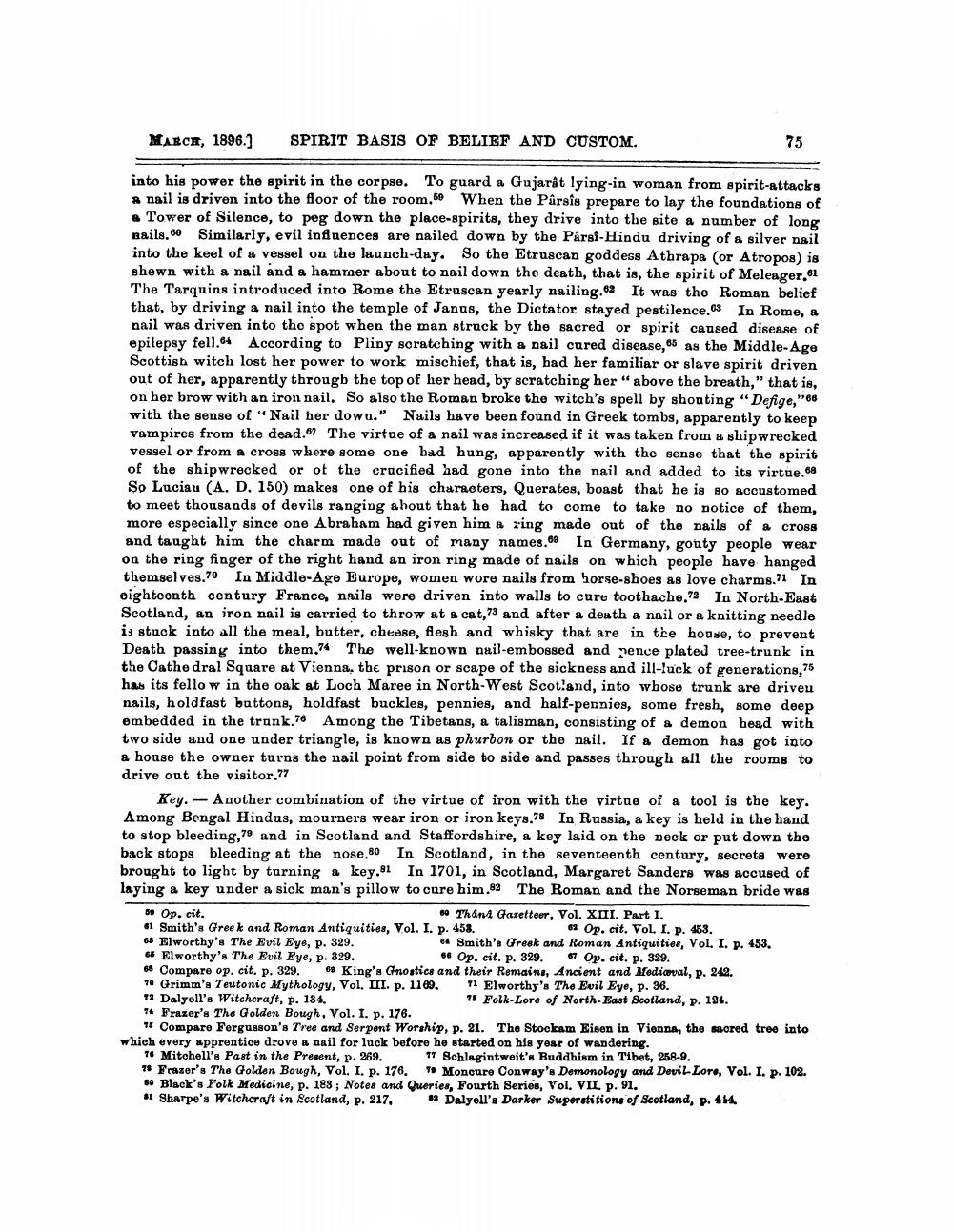________________
MAECE, 1896.]
SPIRIT BASIS OF BELIEF AND CUSTOM.
75
into his power the spirit in the corpse. To guard a Gujarat lying-in woman from spirit-attacks # nail is driven into the floor of the room.69 When the Parsis prepare to lay the foundations of - Tower of Silence, to peg down the place-spirits, they drive into the site a number of long nails.60 Similarly, evil influences are nailed down by the Pårsf-Hindu driving of a silver nail into the keel of a vessel on the launch-day. So the Etruscan goddess Athrapa (or Atropos) is shewn with a nail and a hamraer about to nail down the death, that is, the spirit of Meleager.61 The Tarquins introduced into Rome the Etruscan yearly nailing.62 It was the Roman belief that, by driving a nail into the temple of Janus, the Dictator stayed pestilence. In Rome, & nail was driven into the spot when the man struck by the sacred or spirit caused disease of epilepsy fell.64 According to Pliny scratching with a nail cured disease, 65 as the Middle-Age Scottish witch lost her power to work mischief, that is, had her familiar or slave spirit driven out of her, apparently througb the top of her head, by scratching her "above the breath," that is, on her brow with an iron nail. So also the Roman broke the witch's spell by shooting "Defige, "66 with the sense of "Nail her down." Nails have been found in Greek tombs, apparently to keep vampires from the dead.87 The virtue of a nail was increased if it was taken from a shipwrecked vessel or from a cross where some one bad hung, apparently with the sense that the spirit of the shipwrecked or ot the crucified had gone into the nail and added to its virtue.68 So Lucian (A. D. 150) makes one of his characters, Querates, boast that he is so accustomed to meet thousands of devils ranging about that he had to come to take no notice of them, more especially since one Abraham had given him a ring made out of the nails of a cross and taught him the charm made out of many names. In Germany, gonty people wear on the ring finger of the right hand an iron ring made of nails on which people have hanged themselves.70 In Middle-Age Europe, women wore nails from horse-shoes as love charms.71 In eighteenth century France, nails were driven into walls to cure toothache.72 In North-East Scotland, an iron nail is carried to throw at a cat,73 and after a death a nail or a knitting needle is stuck into all the meal, butter, cheese, flesh and whisky that are in te house, to prevent Death passing into them,74 The well-known nail-embossed and pence plated tree-trunk in the Cathedral Square at Vienna, the prison or scape of the sickness and ill-luck of generations, 75 has its fellow in the oak at Loch Maree in North-West Scotland, into whose trunk are driven nails, holdfast buttons, holdfast buckles, pennies, and half-pennies, some fresh, some deep embedded in the trank.76 Among the Tibetans, a talisman, consisting of a demon head with two side and one under triangle, is known as phurbon or the nail. If a demon has got into a house the owner turns the nail point from side to side and passes throngh all the rooms to drive out the visitor.77
Key. - Another combination of the virtue of iron with the virtue of a tool is the key. Among Bengal Hindus, mourners wear iron or iron keys.78 In Russia, a key is held in the hand to stop bleeding,79 and in Scotland and Staffordshire, a key laid on the deck or put down the back stops bleeding at the nose.80 In Scotland, in the seventeenth century, secrets were brought to light by turning key,81 In 1701, in Scotland, Margaret Sanders was accused of laying a key under a sick man's pillow to cure him.82 The Roman and the Norseman bride was 5 Op. cit.
Than Gazetteer, Vol. XIII. Part I. a Smith's Greek and Roman Antiquities, Vol. I. p. 453.
2 Op. cit. VOL. I. p. 453. 6 Elworthy's The Evil Eye, p. 329.
Smith's Gresk and Roman Antiquities, Vol. I. p. 453. 66 Elworthy's The Evil Eye, p. 329.
66 Op. cit. p. 329. 67 Op. cit. p. 329. 68 Compare op. cit. p. 329. King's Gnostics and their Remains, Ancient and Mediwal, p. 242. 7Grimm's Teutonic Mythology, Vol. III. p. 110. 11 Elworthy's The Evil Eye, p. 36. 12 Dalyell's Witchcraft, p. 184.
* Folk-Loro of North-East Scotland, p. 124. ** Frazor's The Golden Bough, Vol. I. p. 176.
15 Comparo Fergusson's Tree and Serpont Worship, p. 21. The Stockam Eisen in Vienna, the sacred tree into which every apprentice drove a nail for luck before he started on his your of wandering.
T6 Mitchell's Past in the Present, p. 269. 17 Schlagintweit's Buddhism in Tibet, 258-9. 78 Frazer's The Golden Bough, Vol. I. p. 176. * Moncure Conway's Demonology and Devil Lore, Vol. I. p. 102. ** Black's Folk Medicine, p. 183; Notes and Queries, Fourth Series, Vol. VII. p. 91. # Sharpe's Witcheraft in Scotland, p. 217, Dalyell's Darker Superstitions of Scotland, p. 14




